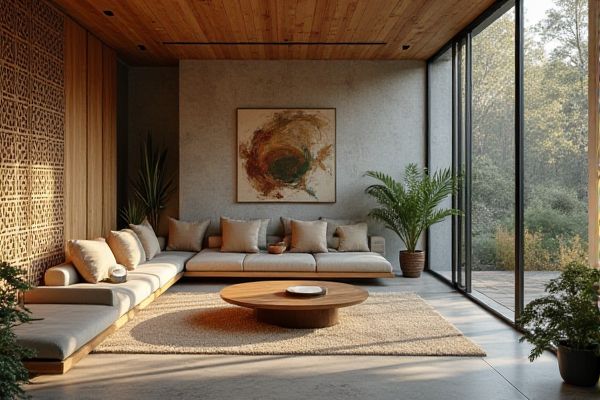
A lattice wall provides partial privacy and airflow, making it ideal for defining spaces without blocking light or ventilation, while a full enclosure offers complete privacy and protection from elements, creating a more secure and insulated area. Discover which option best suits Your needs by reading the rest of the article.
Table of Comparison
| Feature | Lattice Wall | Full Enclosure |
|---|---|---|
| Privacy | Partial privacy with gaps | Complete privacy and security |
| Airflow | High airflow and ventilation | Limited airflow, may require ventilation system |
| Light Transmission | Allows natural light through gaps | Blocks most natural light |
| Material Usage | Less material, cost-effective | More material, higher cost |
| Installation Complexity | Simple and quick to install | Requires more time and effort |
| Typical Applications | Garden borders, patios, decorative partitions | Secure rooms, soundproofing, climate control |
| Durability | Moderate, exposure to elements | High, better protection from elements |
Introduction to Lattice Walls and Full Enclosures
Lattice walls provide a semi-open structure that allows for airflow and natural light while offering privacy and decorative appeal, making them ideal for gardens and patios. Full enclosures offer complete coverage, protecting spaces from weather and insects, creating a controlled environment perfect for year-round use. Your choice depends on the balance between openness and protection you need for your outdoor area.
Structural Differences Between Lattice Walls and Full Enclosures
Lattice walls consist of a grid-like pattern of intersecting strips, providing partial visibility and ventilation while offering moderate structural support. Full enclosures use solid panels that fully enclose a space, delivering maximum privacy, durability, and protection against external elements. Choosing between lattice walls and full enclosures depends on your need for airflow versus complete coverage and structural strength.
Aesthetic Appeal: Lattice Versus Solid Designs
Lattice walls offer a visually lighter, intricate pattern that enhances outdoor spaces with natural light and airflow, creating a decorative ambiance. Full enclosure walls provide a solid, uniform surface that emphasizes privacy and a bold, modern aesthetic. Choosing between lattice and full enclosure designs depends on balancing transparency and enclosure to suit the desired aesthetic appeal.
Privacy Considerations: Which Option Delivers More?
Full enclosures provide significantly higher privacy levels by completely blocking sight and sound, making them ideal for confidential spaces and personal areas. Lattice walls offer partial privacy with decorative openings that allow light and air flow but may still expose your activities and conversations. For maximum privacy, a full enclosure delivers superior protection compared to a lattice wall.
Security Comparison: Protecting Your Space
Lattice walls offer moderate security by providing visibility and ventilation while serving as a deterrent for casual intruders. Full enclosures deliver enhanced protection with solid, continuous barriers that effectively prevent unauthorized access and shield your space from external threats. Choosing between the two depends on your security needs, with full enclosures being the superior option for maximizing safety and privacy.
Ventilation and Airflow: Benefits of Lattice and Full Enclosure
Lattice walls provide superior ventilation by allowing continuous airflow through their open grid design, making them ideal for areas requiring natural cooling and moisture control. Full enclosures offer more controlled airflow and enhanced protection from external elements, suitable for spaces needing privacy and security while still permitting occasional ventilation through vents or windows. Choosing between lattice walls and full enclosures depends on the balance between airflow needs and environmental control requirements specific to the application.
Durability and Maintenance Requirements
Lattice walls offer moderate durability with potential susceptibility to weather damage and require regular maintenance such as painting or sealing to prevent rot and wear. Full enclosures, often constructed from solid materials like vinyl or aluminum, provide superior durability with minimal maintenance, resisting harsh weather conditions and pests effectively. Choosing a full enclosure reduces long-term upkeep costs and extends the lifespan of the structure compared to lattice walls.
Cost Analysis: Budgeting for Lattice or Full Enclosure
Evaluating the cost differences between lattice walls and full enclosures is essential for effective budgeting. Lattice walls typically offer a more affordable option due to lower material and installation expenses, while full enclosures require higher investment because of extensive materials and labor. Your choice will impact overall project costs, making it crucial to balance budget constraints with desired functionality and aesthetics.
Best Applications: Choosing the Right Design for Your Needs
Lattice walls are ideal for spaces requiring partial privacy and enhanced airflow, such as garden partitions, patios, or office cubicles, providing a visually appealing yet open structure. Full enclosures offer complete privacy and security, making them suitable for bedrooms, offices, or storage areas where noise reduction and controlled environments are critical. Selecting the right design hinges on balancing the need for openness versus seclusion, depending on factors like ventilation requirements, noise control, and aesthetic preferences.
Conclusion: Making the Optimal Choice for Your Project
Choosing between a lattice wall and a full enclosure depends on your project's priorities such as privacy, airflow, and aesthetic appeal. Lattice walls offer enhanced ventilation and a lighter design, making them ideal for outdoor spaces needing partial screening. Full enclosures provide maximum privacy and security, making them the optimal choice for projects where containment and complete separation are essential.
 homyna.com
homyna.com